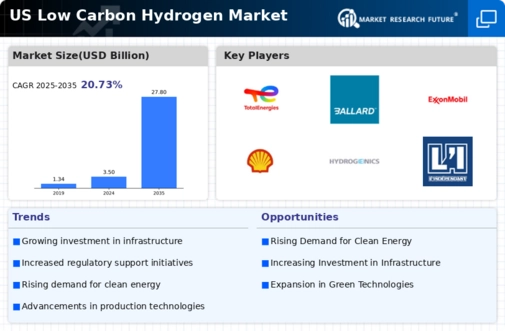The low carbon hydrogen market is currently characterized by a dynamic competitive landscape, driven by increasing demand for sustainable energy solutions and stringent regulatory frameworks aimed at reducing carbon emissions. Key players such as Air Products and Chemicals Inc (US), Plug Power Inc (US), and Linde plc (US) are strategically positioning themselves through innovation and partnerships to capture market share. Air Products and Chemicals Inc (US) focuses on large-scale hydrogen production and has made significant investments in infrastructure, while Plug Power Inc (US) emphasizes the development of fuel cell technologies and green hydrogen solutions. Linde plc (US) is leveraging its global presence to enhance supply chain efficiencies and expand its hydrogen production capabilities, collectively shaping a competitive environment that prioritizes sustainability and technological advancement.
In terms of business tactics, companies are increasingly localizing manufacturing and optimizing supply chains to enhance operational efficiency. The market appears moderately fragmented, with several players vying for dominance. However, the collective influence of major companies is notable, as they engage in strategic collaborations and mergers to strengthen their market positions. This competitive structure fosters innovation and drives advancements in hydrogen production technologies, which are essential for meeting growing energy demands.
In November 2025, Air Products and Chemicals Inc (US) announced a partnership with a leading renewable energy firm to develop a new hydrogen production facility in Texas. This strategic move is expected to enhance their production capacity and reduce costs, positioning them favorably in the market. The collaboration underscores the importance of integrating renewable energy sources into hydrogen production, aligning with global sustainability goals.
In October 2025, Plug Power Inc (US) unveiled a new initiative aimed at expanding its hydrogen fuel cell network across the northeastern United States. This expansion is likely to enhance their service offerings and improve accessibility for customers, thereby solidifying their market presence. The initiative reflects a broader trend towards increasing the availability of hydrogen solutions in key regions, which is crucial for driving adoption.
In September 2025, Linde plc (US) completed the acquisition of a regional hydrogen production company, which is anticipated to bolster its operational capabilities and market reach. This acquisition not only enhances Linde's production capacity but also allows for greater integration of advanced technologies in hydrogen production processes. Such strategic actions are indicative of a trend where companies seek to consolidate resources and expertise to remain competitive.
As of December 2025, current competitive trends in the low carbon hydrogen market include a pronounced focus on digitalization, sustainability, and the integration of artificial intelligence in production processes. Strategic alliances are increasingly shaping the landscape, enabling companies to pool resources and share expertise. Looking ahead, competitive differentiation is likely to evolve from traditional price-based competition to a focus on innovation, technological advancements, and supply chain reliability. This shift suggests that companies that prioritize these elements will be better positioned to thrive in an increasingly competitive environment.























Leave a Comment